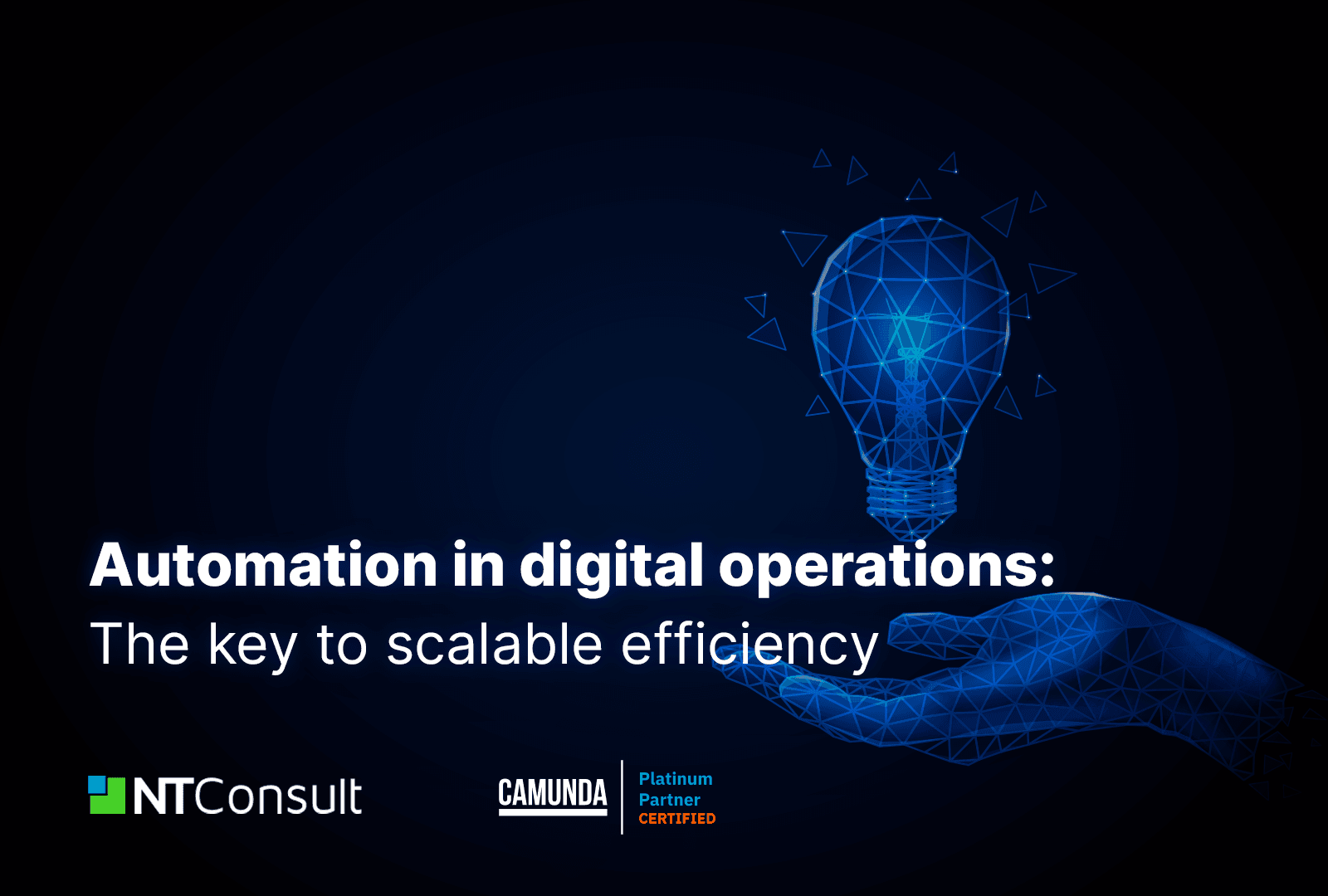Automation has evolved from a tactical IT tool to a strategic priority across enterprise environments. In modern digital infrastructures, the growing need for speed, scale, and consistency demands solutions that go beyond manual intervention.
Automation today plays a key role in aligning IT operations with business outcomes. It’s more than task execution. It’s the foundation for scalable systems, agile teams, and intelligent decision-making.
This article explores:
- How to choose the right automation partner
- What automation means in large-scale digital enterprises
- Where it creates the most value
- The different automation types and when to use them
- How to build a sustainable strategy
What is automation in the digital enterprise?
Enterprise automation enables systems to interact, execute processes, and self-correct with minimal manual intervention. It differs from industrial or consumer automation by focusing on digital operations, software delivery, and infrastructure management.
Definitions on Automation point to the convergence of scripting, APIs, and AI for faster, smarter operations.
Key areas of application include:
- IT provisioning and monitoring
- Continuous Integration and Continuous Deployment and application deployment
- Enterprise workflow orchestration
Platforms like Camunda bridge process modeling with execution, making digital process automation reliable and traceable across large systems.
Benefits of automation in complex digital environments
In sectors with dense infrastructure and strict uptime requirements, automation drives measurable gains.
Top benefits:
- Consistency: Repeatable processes reduce human error
- Efficiency: Speeds up deployment, reduces delays
- Cost-effectiveness: Frees teams for strategic work
- Compliance: Helps meet security and regulatory standards
According to Spiceworks, 67% of IT leaders prioritize automation to manage system complexity.
When orchestrated well, automation enhances visibility and control across systems — not just isolated tasks.
Types of automation and when to use them
Different automation strategies serve distinct purposes, but they often work best when combined to support core business operations at scale. Rather than thinking of them as isolated tools, it’s more effective to view them as components of a flexible automation architecture.
Each of the technologies and strategies listed below can be applied across a wide range of scenarios and industries. However, for illustrative purposes, we’ve selected specific examples that highlight their real-world impact, demonstrating how they directly drive business value.
| Type | What it does | When to apply |
| Robotic Process Automation | Automates high-volume, rule-based tasks without altering existing systems | Ideal for repetitive actions across systems — from finance to customer service |
| Business Process Automation | Digitizes and integrates end-to-end business processes across teams and platforms | Can be used for improving structured workflows such as procurement, billing, or compliance |
| Intelligent Automation | Adds AI to automation — enabling decisions, learning, and exception handling | Effective for complex, variable processes like fraud detection or claims processing |
| Orchestration | Coordinates multiple tasks, teams, and technologies into streamlined, unified workflows | Critical in environments with multiple systems and stakeholders — such as IT ops, telecom, or large-scale service delivery |
Why hybrid models work
In real-world scenarios, the most successful automation strategies blend these approaches:
- Combine task automation with process orchestration to reduce fragmentation
- Use intelligent automation to handle unstructured data or real-time decisions
- Ensure platform compatibility with core systems, including legacy applications
- Engage nearshore teams or cross-functional squads to accelerate delivery and adoption
Rather than replacing processes, automation reshapes them, enabling greater consistency, scalability, and visibility across the organization’s most valuable operations.
Building an automation strategy that scales
A successful automation roadmap balances technology, governance, and business goals.
Key elements:
- Choose the right processes — target manual, high-volume, or error-prone flows.
- Plan for integration — ensure systems are API-ready.
- Governance and KPIs — track value, security, and performance.
Implementation roadmap:
- POC: Test feasibility on a small process;
- Pilot: Expand to a business unit;
- Scale: Deploy across the organization.
Common blockers include outdated systems, limited skills, and resistance to change. NTConsult helps teams navigate these with advisory support and scalable tech implementation.
Real-world use cases in banking and financial services
Banks have adopted automation to address risk, regulation, and service speed.
Common applications:
- Know Your Customer: Real-time verification and onboarding;
- Fraud detection: AI monitoring for anomalies;
- Credit workflows: Automated loan processing;
- Regulatory compliance: Real-time reporting and reconciliations.
These require close integration with legacy systems. NTConsult has experience delivering secure, regulation-ready solutions that modernize without disruption.
Real-world use cases in telecom and infrastructure
Telecom firms rely on automation to manage scale and ensure service quality.
Examples:
- Operations Support System and Business Support System automation (OSS/BSS) automation: Manage provisioning and billing.
- Network orchestration: Enable zero-touch configuration.
- Compliance workflows: Automate logging and auditing.
NTConsult has supported major telecom providers with robust orchestration and automation across distributed systems.
Choosing the right automation partner
Selecting a capable partner is essential for long-term success.
What to look for:
- Deep system integration knowledge;
- Agile delivery methods;
- Experience with legacy systems;
- Long-term support.
While nearshore teams improve communication, the real value lies in a partner’s ability to deliver aligned, strategic outcomes.
NTConsult brings domain expertise and a track record of successful automation in complex infrastructures.
Automation is central to scalable, resilient operations. It enables businesses to move faster, reduce errors, and make smarter decisions when implemented with strategy and clarity.
Ready to scale your automation strategy?
Talk to our enterprise automation experts and discover how NTConsult can help you design, implement, and scale a high-performance digital operations framework starting today.
FAQ – Frequently Asked Questions about Automation
Large enterprises apply automation in areas such as fraud detection, loan and credit processing, network provisioning, and internal audits. In telecom, it enables rapid service deployment and system integration. In banking, it supports compliance, onboarding, and operational efficiency — often across departments at scale.
2. How do I know if a process is ready to be automated?
A process is ready for automation when it is repetitive, rule-based, high in volume, low in variability, and tied to measurable business outcomes. However, not every manual process should be automated. Long-term success also depends on factors such as process maturity, proper documentation, and operational stability.
3. What’s the ROI of automation for enterprise operations?
ROI goes beyond simply reducing costs; it also encompasses faster service level agreements (SLAs) and cycle times, less rework and fewer errors, and improved compliance and audit readiness. Additionally, ROI tends to grow as automation scales and more workflows are integrated across departments, amplifying efficiency and business impact.
4. Can automation coexist with legacy systems?
Yes. Especially through RPA, APIs, and integration platforms. Many organizations successfully automate around legacy systems without full replacement. However, automating unstable legacy components can introduce risk. A phased modernization approach with automation layers is often the most effective path forward.
5. How is AI being used in enterprise automation today?
AI is enhancing enterprise automation through decision automation, anomaly detection in security and finance, and natural language processing (NLP) for ticket routing and chatbots. While rule-based automation remains foundational, AI adds dynamic, data-driven logic. Explainability is critical, especially in regulated industries like banking and insurance.
6. Is automation secure for regulated industries?
Yes, automation can be secure for regulated industries. Secure automation requires role-based access control, full audit trails, encryption of data in motion and at rest, and process-level governance. Banks and telecoms regularly meet regulatory standards while automating, and NTConsult supports compliance through architecture aligned with security and industry best practices.
7. What automation tools are best for large-scale operations?
The best automation tools for large-scale operations fall into key categories such as workflow engines, RPA tools, orchestration platforms, and low-code automation tools. Rather than focusing on specific vendors, organizations should evaluate tools based on scalability, integration capabilities, and vendor support. NTConsult often implements orchestration solutions like Camunda for clients needing enterprise-wide automation.


 Portuguese
Portuguese Spanish
Spanish


